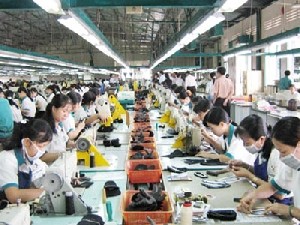 |
| Production of leather shoes for exports at Gia Dinh Shoe Company. (Photo: www.tinkinhte.com) |
(VOVworld) - Being one of the world’s 5 major footwear exporters, Vietnam still has to import most of its raw materials. To solve this scenario, the Vietnam Leather and Footwear Industry is putting together a chain of suppliers to increase the ratio of domestic raw materials which will raise the profit on each exported item. This is also a key part of the industry’s strategy for the near future. VOV editor To Tuan, investigates what the country has done to increase the use of domestic materials.
Over the past decade, the leather and footwear industry has been one of Vietnam’s five biggest hard currency earners. This year, despite several difficulties, the sector estimates it will earn around 7 billion USD in export revenue. But economists say the country’s leather and footwear exports still face many risks due to global fluctuations and because Vietnam itself depends too much on imports. However this has lowered the competitiveness of Vietnamese products. To settle this, the industry is trying to link companies with a chain of suppliers and to be more active to ensure a sustainable growth. Nguyen Thi Tong, Secretary General of the Vietnam Leather and Footwear Association, says ‘The chain of suppliers will link both domestic and foreign producers together. With all current development in the sector, major businesses can attract satellite companies and producers to take part in the production process’.
In the plans to develop Vietnam’s leather and footwear industry by 2020, the sector has paid special attention to forming a chain of suppliers. Increasing the ratio of domestic material is considered key for the years to come. This will help footwear firms not only to increase their competiveness, but it will also help them to make the best of existing free trade agreements Vietnam has signed up to. Most these agreements offer preferential taxes, particularly on exports and imports. But to be able to enjoy these tariffs, Vietnamese exporters must meet the standards set by FTAs. One of them is proving the origin of their products and the materials used to ensure the production is legitimate and doesn’t harm consumers. Ms. Nguyen Thi Tong says again ‘The current fierce competition has required Vietnamese companies to satisfy international standards, specifically on the environment, and use less harmful substances. Domestic companies must prioritize the issues in the strategy to expand our export markets’.
Vietnam is negotiating a Free Trade Agreement with the European Union, which is one of the country’s major export markets. Trieu Dinh Dung, Deputy Director of the Multilateral Trade Department at the Ministry of Industry and Trade, says ‘More and more domestic companies have made full use of their free trade agreements. Some only require 90% of the materials used to be these. The EU is a major market for Vietnam’s leather and footwear products, accounting for 50% of the total exports, while the US makes up only 20%. The increase of the ratio of domestically-made materials is to meet the requirements on the origin of exports’.
The ratio of domestic materials used by the leather and footwear industry is almost 40% while that garments and textiles are only 20%.
To Tuan